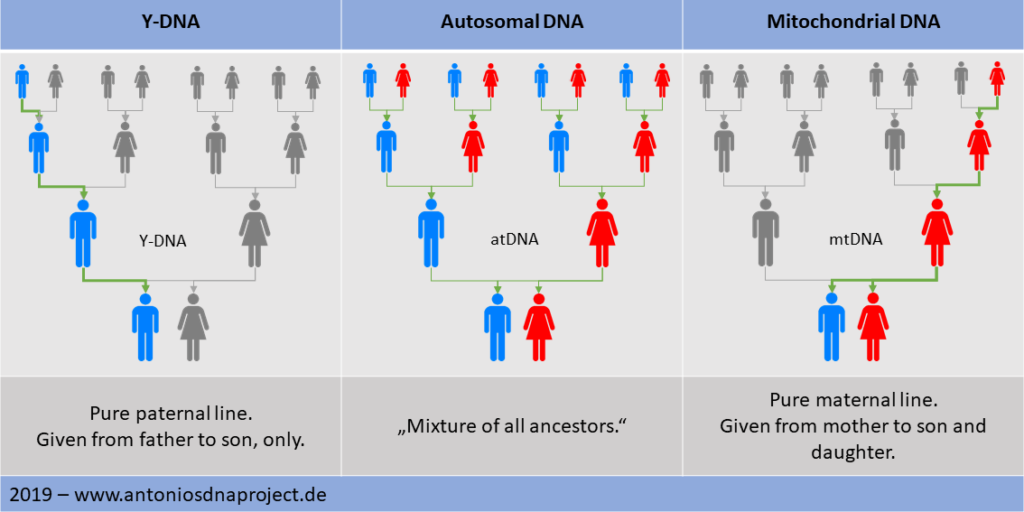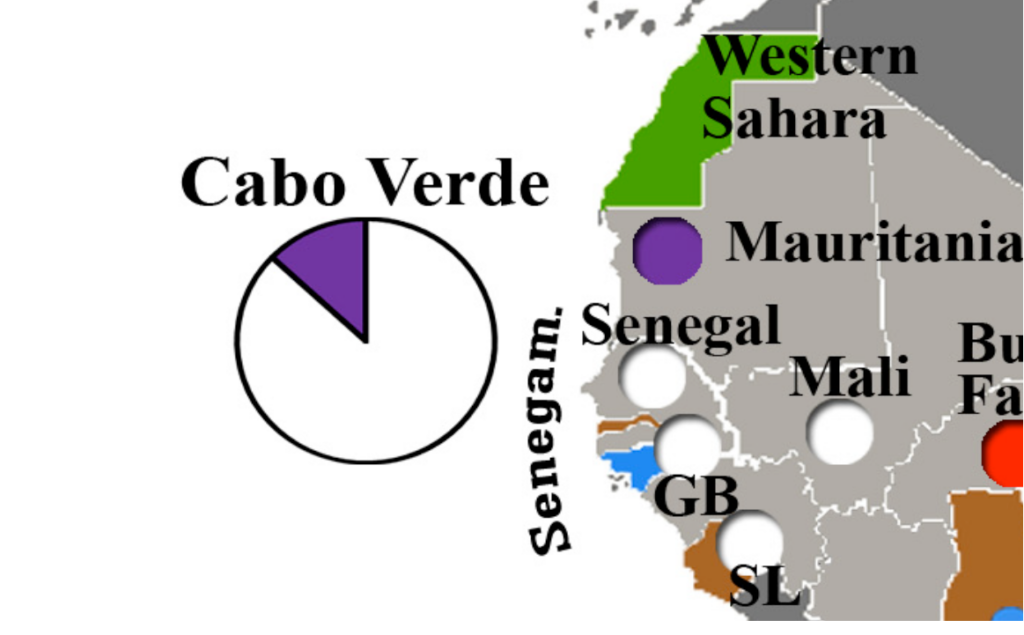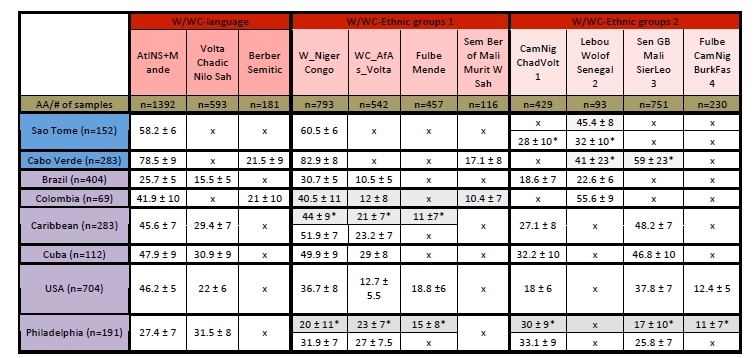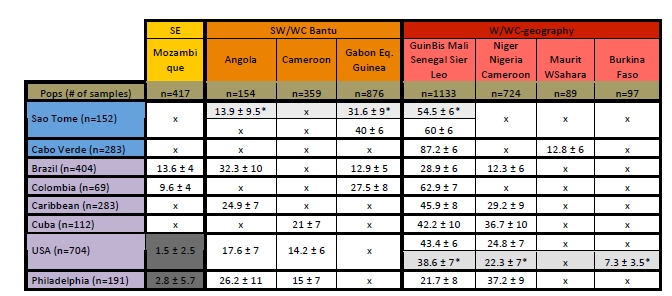There have been several studies on Cape Verdean maternal and paternal haplogroups. Uniparental analysis is of course less predictive of ancestral composition than autosomal analysis which covers your entire DNA (genomewide). Direct parental lineages, as indicated by mtDNA and Y-DNA, are by default only measuring a very restricted part of your DNA (see this link). But still given the inherent limitations there have been very interesting outcomes.1
Figure 1 (click to enlarge)

***
Overall speaking the main takeaways are that Cape Verdeans overwhelmingly have African foremothers (>90%) while their male forefathers often tend to be European, ultimately.2 Zooming into the specifics it has been established that as a whole Cape Verdean maternal haplogroups are firstmost reflective of origins from Senegambia & Guinea. I will not discuss all of these studies in detail. But see below for an overview (not meant to be exhaustive!).
- Mitochondrial portrait of the Cabo Verde archipelago: the Senegambian outpost of Atlantic slave trade (Brehm et al., 2002)
- Y-chromosome lineages in Cabo Verde Islands witness the diverse geographic origin of its first male settlers. (Gonçalves et al., 2003)
- Cabo Verde islands: different maternal and paternal heritage testifies the nature of its first settlers (Gonçalves et al., 2004)
- Dissecting the Within-Africa Ancestry of Populations of African Descent in the Americas (Stefflova et al., 2011)
- Genetic portrait of Lisboa immigrant population from Cabo Verde with mitochondrial DNA analysis (Morais et al., 2015)
See this link below for a general overview of African haplogroup frequencies and studies:
- African Haplogroups (Tracing African Roots)
***
Mitochondrial portrait of the Cabo Verde archipelago: the Senegambian outpost of Atlantic slave trade (2002)
Table 1 (click to enlarge)

____________________
“Summary
In order to study the matrilineal genetic composition in Cabo Verde (Republic of Cape Verde), an archipelago that used to serve as a Portuguese entrepot of the Atlantic slave trade, we have analysed a total of 292 mtDNAs sampled from the seven inhabitated islands for the hypervariable segment I (HVS-I) and some characteristic RFLPs of the coding regions. The different settlement history of the northwestern group of the islands is well reflected in the mtDNA pool. The total Cabo Verde sample clearly displays the characteristic mitochondrial features of the Atlantic fringe of western Africa and testifies to almost no mitochondrial input from the Portuguese colonizers.” (Brehm et al., 2002).
____________________
Figure 2 (click to enlarge)

“Figure 2 displays the resulting twodimensional PC plot. The first component reflects a clear NW-SE cline, where NW Cabo Verde is paired with Senegal (Mandenka), SE Cabo Verde with Senegal (mixed), the Dominican Republic with Niger}Nigeria, and Brazil with Mozambique. This gives some hints at the ancestry of the populations that were ultimately created by slave trade.” (Brehm et al., 2002).
____________________
Basically this study is saying that Cape Verde’s mtDNA profile fits best with the mtDNA variation as found in Senegambia. Quote below is stating that the northwestern Cape Verdean islands show a subset of variety as found in Santiago/Fogo (“SE Cabo Verde”).
____________________
“The differences in haplotype frequencies […] between SE Cabo Verde and NW Cabo Verde are striking, but parallel the significant serological differences found between Santiago and Santo Antao/Sao Vicente (Lessa & Ruffie!, 1960). Nevertheless, the major haplotypes in both regions are nearly the same, and no haplogroups were found in the NW group that were not already sampled in the SE group of islands. On the other hand, the former islands seem to be missing three minor haplogroups of the latter islands.” (Brehm et al., 2002).
____________________
Interestingly this study mentions that possibly Mandenka fugitive slaves may have caused a founding effect in Santo Antão. Which in turn also influenced the population structure of neighbouring São Vicente (which was settled mostly by way of Santo Antão). Surely there must have been other ethnicities involved as well though. Too bad no reference/footnote is provided for these “historical records”. From all the historical sources I have read myself I never came across anything which could back up this particular scenario. In particular the part involving runaway slaves fleeing from Santiago to Santo Antão by boat seems unlikely… Because these islands are quite far removed from each other. Frankly I therefore suspect this was merely speculation on part of the authors of this study (who are not trained historians). Like they suggest further research is needed for clarification.
____________________
____________________
Dissecting the Within-Africa Ancestry of Populations of African Descent in the Americas (2011)
____________________
“Our admixture analysis indicated that the current population of Cabo Verde derives solely from West Africa (~100% from W/WC, not including Bantu speakers or Pygmy), namely from West Niger-Congo speakers of Guinea-Bissau, Senegal, and Sierra Leone (~90%) and Semitic/Berber speakers of Mauritania, Mali and Western Sahara (~10%).” (Stefflova et al., 2011)
____________________
Figure 3 (click to enlarge)

***
This study basically compares the Cape Verdean mtDNA variation with an extensive database consisting of 5800 individuals from 143 African populations. Confirming the main outcome of Brehm et al. (2002) that the maternal lineages of Cape Verdeans trace back to Upper Guinea, for the most part. But they put this in greater perspective by also comparing with other Afro-Diasporan populations. See link below for a more detailed discussion of this insightful study:
- Locating Afro-Diasporan haplogroups within Africa (Fonte Felipe, 2015)
In Table 2 below 41% of Cape Verdean maternal haplogroups are being shown as most similar to Wolof/Lebou from Senegal. And 59% of Cape Verdean haplogroups are deemed to be similar to mtDNA variation in Guiné Bissau and Mali. Of course this shouldn’t be mutually exclusive ancestrally speaking. In other words persons with a haplogroup most commonly found among the Wolof might still have significant ancestry from Guiné Bissau as well.
Table 2 (click to enlarge)

***
Also interesting to see the relatively high Berber/Mauretania similarity being mentioned. This corroborates the minor North African %’s scored by Cape Verdeans when tested by personal DNA testing companies such as 23andme or Ancestry (see also this section). I suppose this North African affinity could signal either direct ancestry from Berber/Morisco’s/Guanche but also indirectly via Fula. Eventhough in this particular study no similarity was found with Fula mtDNA variation. But that’s perhaps because their Fula samples are not from Upper Guinea but rather from Cameroon/Niger/Burkina Faso.
Table 3 (click to enlarge)

___________________________________________________________________________
Notes
1) On an aggregated population level the analysis of haplogroup frequencies is usually very insightful. But haplogroup studies are by no means intended to be conclusive! Especially not on an individual level. One should be very careful when wanting to apply generalized findings to your personal DNA results. Regrettably the ancestral significance of haplogroups is often misconstrued or misunderstood.
It is good to keep in mind that one’s direct maternal or paternal line represents a very small portion of your overall ancestry if you go back to your first African-born (mainland) ancestor. Around 1% only or even less. Also it should be realized that Cape Verdeans are almost by default descended from atleast 20 ethnic groups, due to the ethnic intermingling across the generations (see this section). This is the reason I personally have always preferred to get tested for my autosomal admixture test results, to get insight into my ENTIRE ancestry. See also:
- Fictional Family Tree incl. African Born Ancestors (Fonte Felipe, 2015)
- Just Say No: African Ancestry’s DNA Tests (Shannon Christmas, 2019)
2) Cape Verdeans usually have European and not African paternal haplogroups. This is in line with so-called sex-biased admixture. Also commonly observed among other parts of the Atlantic Afro-Diaspora. This means that historically speaking European DNA has usually been inherited by way of male ancestors. Which is especially detectable from Y-DNA. European/Portuguese settlers in Cape Verde have been overwhelmingly male. While European/Portuguese women were very rare. So this outcome should not be really surprising.
Regarding the nature of this European geneflow I think it’s wise to refrain from “weaponizing” history without knowing all the actual details. Aside from structural forces enabling abuse there would usually also be room for individual agency. Victim-perpetrator narratives do not always apply or turn out be much more nuanced than imagined. Of course I am not in favour of any continued sugarcoating of all the horrible practices which took place during the colonial era. However at the same time I do also think that a one-sided and heavily Americanized way of framing things is not going to contribute to a balanced evaluation and complete narrative of complex histories. In particular such an approach is at risk of obscuring and distorting important localized variations across the Afro-Diaspora.
Either way it is important to keep in mind that personal family histories are bound to sometimes deviate from the assumed narrative. Ultimately it might be self-defeating to allow generalizations about European admixture to determine how you should feel about your own unique DNA makeup. Especially without at least having done any basic genealogical & historical research of your own in advance. You might then of course still encounter many negative aspects. Especially when solely judging through a modern moral lens. However also often unexpected details might turn up enriching your research and making it more insightful. Things are often far more complex, inter-connected and intricate than you might assume at first.
For example it is pertinent to be aware of the fact that especially during the 1800’s there was an increase of Portuguese exiled men being sent to Cape Verde. Most of them ended up being absorbed in the local population. Given the rarity of European women naturally they would usually have local Cape Verdean partners. And again at that time the share of enslaved persons would be below 10%. For more details see:
- “Cabo Verde: formação e extinção de uma sociedade escravocrata (1460-1878)”, (António Carreira, 2000, p.411, p.415)

